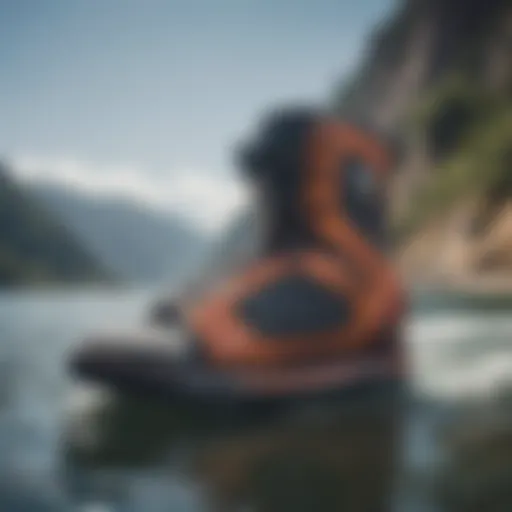Choosing the Ideal Sailing Harness for Water Sports

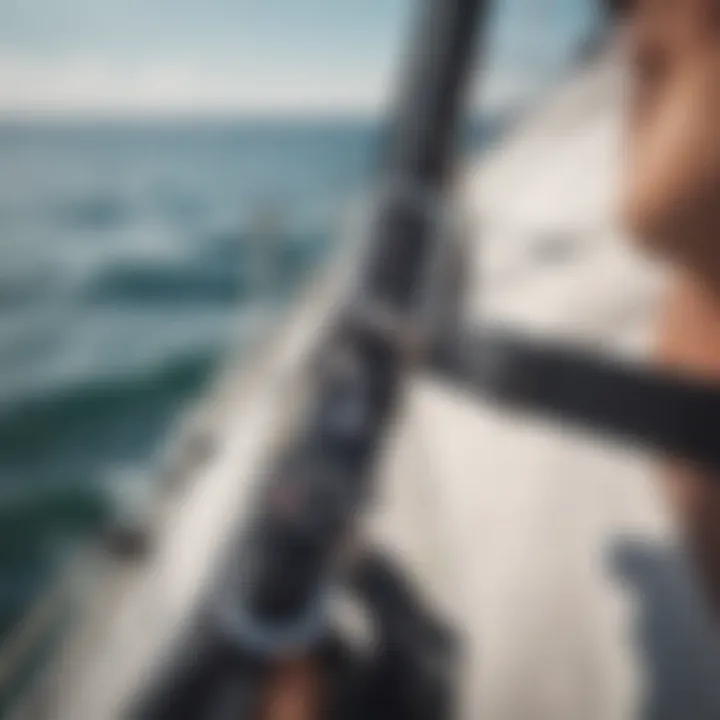
Intro
For many outdoor adventurers, sailing represents a confluence of skill, joy, and communion with nature. The feeling of gliding over the water, harnessing the wind, and the call of adventure are intoxicating. Yet, how does one navigate the intricacies of selecting an appropriate sailing harness? This question bears a significant weight. A good sailing harness can mean the difference between a seamless sailing experience and one fraught with discomfort and difficulty.
As water sports enthusiasts embark on their journey, they must appreciate the intricacies involved in their gear selection. A suitable harness not only enhances performance but also prioritizes safety, allowing sailors to focus on the joys of the water rather than the constraints of inadequate equipment. This guide endeavors to shed light on these essential considerations, providing insights into the various features of sailing harnesses that can amplify one’s sailing experience.
The exploration ahead will dissect the fundamental techniques and advanced skills that sailors employ, as well as emphasize the importance of safety measures. Furthermore, the article will delve into gear reviews and recommendations tailored for different conditions to assist sailors of all levels in making informed choices. Let's wind this journey and see what lies ahead in the realm of sailing harnesses!
Understanding the Sailing Harness
Sailing harnesses, while often overlooked, play a pivotal role in the sailing experience. Enthusiasts need to grasp their importance not just for safety but also for enhancing overall performance on the water. A harness isn’t just a piece of equipment; it acts as a lifeline, connecting sailors to their vessel and allowing them to harness the natural forces of wind and water effectively.
In essence, understanding the sailing harness involves recognizing the various elements that contribute to a safe and enjoyable outing. The right harness does more than secure a sailor; it enhances comfort and mobility, allowing for a seamless interaction with both the weather and the boat itself. Key considerations include the material used, fit, safety features, and intended use. Choosing a suitable harness means weighing these factors against one’s personal sailing style and the conditions they are likely to face.
Adopting a well-fitted harness can be the difference between a controlled ride through turbulent waters and a chaotic struggle just to stay aboard. With that in mind, delving into the definitions and historical contexts surrounding sailing harnesses will illuminate why these critical tools deserve the attention of both seasoned sailors and novices alike.
Definition and Purpose
A sailing harness is essentially a piece of equipment designed to secure a sailor to their vessel during operations, particularly in demanding conditions. It's crafted to balance comfort and functionality, allowing sailors to move freely without the fear of being thrown overboard. This equipment typically connects via straps and buckles to the sailing gear, which may include the harness itself attached to the boat's systems.
The primary purpose revolves around providing safety and utility. In high winds or rough seas, the harness allows sailors to lean outboard while maintaining their balance, which is crucial for controlling the boat. Additionally, modern harnesses often include features aimed at boosting comfort, such as padding and adjustable straps. The effectiveness of the harness directly correlates with a sailor’s ability to perform maneuvers with confidence while preserving their safety.
History of Harness Design
The concept of using a harness in sailing isn’t a new one. Historical evidence suggests that sailors have been utilizing various forms of harnesses for centuries, evolving from basic straps made of leather or rope to contemporary designs integrating high-tech materials. The maritime community recognized early on that the forces at play while sailing could be unforgiving. Figures throughout history have crafted more elaborate designs to address these safety concerns.
In the mid-20th century, as sailing evolved into a competitive sport, the demand for more specialized harnesses surged. With the advent of materials like nylon and advancements in design, sailors began to enjoy improved durability and comfort. It wasn’t long before designers experimented with various types of harnesses to fit different sailing styles and conditions, leading to today's diverse array of options including waist, seat, and specialized designs.
With historical changes came a better understanding of ergonomics and safety, leading to innovations that made sailing not only more accessible but also safer.
As we explore the contemporary landscape of sailing harnesses, it becomes clear that knowing the evolution of harness design informs our choices today—offering clues to what features matter most depending on individual sailing preferences and environments.
Key Features to Consider
Choosing a sailing harness involves more than just picking one off the shelf; it's about understanding what makes a harness function effectively in the water. Attention to particular features can enhance both safety and performance, ensuring that sailors can enjoy their time on the waves without unnecessary worries. As we dive into the essential elements of harness construction, discerning enthusiasts can make informed choices tailored to their needs.
Material Quality
Material quality serves as the backbone of a sailing harness. A well-crafted harness not only withstands the rigors of the ocean but also provides comfort during prolonged use. Materials like high-denier nylon or polyester are popular selections, offering durability while being lightweight.
Moreover, high-quality materials often come with water-resistant treatments, preventing absorption of moisture that can add unnecessary weight and lead to chafing. A seasoned sailor will appreciate how reinforced stitching and robust fabric choices lend longevity and resilience. This aspect underscores the importance of investing in a harness that outlasts the usual wear and tear, ultimately offering better value over time.
Adjustability and Fit
Every sailor has a different body shape, and adjustability is crucial to ensure that a harness snugly fits without compromising movement. Most harnesses feature adjustable straps and buckles to cater to varied body types. Finding a harness that allows for precise fit adjustments can significantly enhance comfort and effectiveness on the water.
A well-fitting harness minimizes the risk of slipping or digging into the skin, providing the right balance between support and freedom of movement. Moreover, the ability to adjust can also accommodate different types of clothing worn underneath, whether it’s a wetsuit in colder waters or lighter attire in the summer.
Safety Features
When it comes to sailing, safety can never be overemphasized. A quality harness integrates several safety features, designed to protect users during unexpected situations at sea. Two noteworthy aspects that merit attention are Emergency Release Mechanisms and Smart Harness Sensors, both of which add a significant layer of reassurance.
Emergency Release Mechanisms
Emergency Release Mechanisms stand as a pivotal safety feature. These mechanisms allow sailors to disengage from the harness swiftly during emergencies. A simple pull of a cord or a push of a button can free the sailor from potential entrapment or hazards. The ease of activation is a key characteristic that makes this feature popular among enthusiasts.
What sets some designs apart is the incorporation of a dual-release mechanism, which requires the user to engage two actions for release. This characteristic aims to prevent accidental discharges when navigating rough waters. While very beneficial, it is crucial for sailors to practice with the mechanism before heading out to avoid fumbling in critical moments.
Smart Harness Sensors
Smart Harness Sensors are at the forefront of the latest innovations in sailing harness design. These sensors track heart rate, buoyancy, and even the surrounding water conditions, providing real-time data to the sailor. The information gathered greatly contributes to improved decision-making while on the water.
One unique feature is the ability of some sensors to send alerts to compatible devices during risky conditions, such as strong winds or sudden drops in water temperature. While these sophisticated tools are hugely beneficial, they may come at a higher price point, and integrating them with personal devices requires a bit of tech savvy from the user. Still, embracing technology in safety offers an edge that appeals to the modern-day sailor.
"A well-fitted harness combines material quality, adjustability, and safety features, not only enhancing performance but also ensuring a more enjoyable sailing experience."
The interplay of these key features ultimately shapes the sailor's experience. Selecting a harness that encompasses these elements means choosing safety and comfort for optimal performance on the open waters.

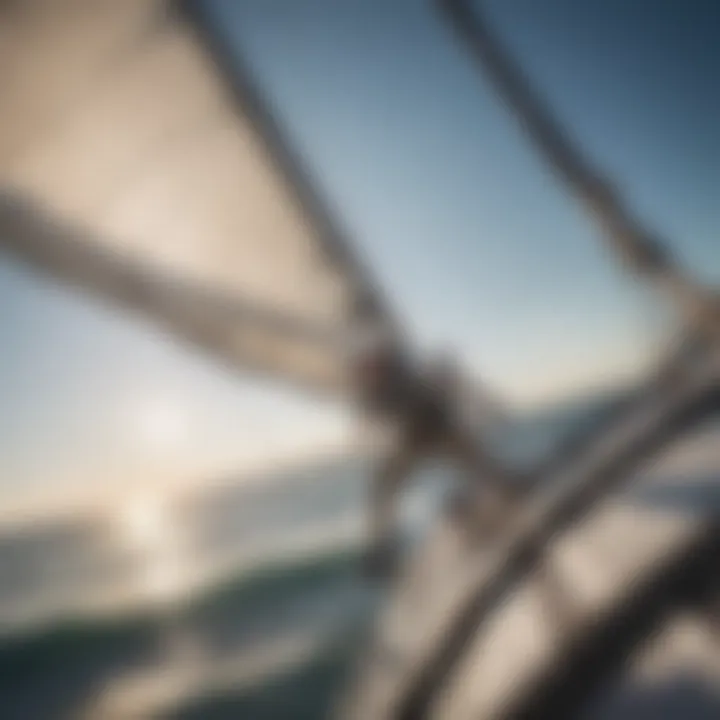
Types of Sailing Harnesses
Understanding the various types of sailing harnesses is crucial for enthusiasts seeking not just comfort but also optimal performance on the water. Different harness designs cater to distinct sailing styles, body types, and skill levels, making it essential to choose wisely. This section breaks down the main types of sailing harnesses, examining their benefits and considerations that every sailor should bear in mind.
Waist Harness
A waist harness is typically worn around the waist and is favored for many forms of windsurfing and kitesurfing. This harness gives the user a higher degree of mobility due to its minimalist design. It allows for greater rotation of the upper body, making it easier to transition from one maneuver to another.
Benefits of the Waist Harness:
- Mobility: The design doesn’t restrict your movements, perfect for tricks and dynamic sailing conditions.
- Comfort: Often padded on the inside, it can be very comfortable for long sessions on the water.
- Fit: Adjustable straps ensure a secure fit, which means fewer distractions while sailing.
However, there are some considerations to keep in mind. Due to its nature, a waist harness may not distribute pressure as well as others during intensive sailing, leading to discomfort for some users. Additionally, they might not be the best choice in extreme wind conditions where support features are crucial.
Seat Harness
Contrasting with the waist harness, the seat harness is worn lower on the body and provides extra support, making it ideal for beginners or those who prefer a more stable riding experience. This type distributes the pull of the sail across a wider range of the body, which can help in maintaining balance.
Benefits of the Seat Harness:
- Support: Offers great back support, which can help prevent fatigue during extended periods on the water.
- Stability: Provides a more anchored feel, which can enhance control in challenging conditions.
- Ease of Use: Often easier to put on and adjust, making it good for both novices and seasoned sailors.
Nonetheless, some users may find them less versatile for high-intensity maneuvers, where a more dynamic motion is necessary. The added bulk can also be a downside for those seeking agile movements.
Leg Straps and Accessories
Leg straps and other accessories enhance any harness system, making the sailing experience more tailored to individual needs and activities. These additional components can significantly increase safety and comfort during use.
Important Accessories Include:
- Leg Straps: Help keep the harness in place, preventing unwanted movement that can lead to discomfort or a reduced ability to control the sail.
- Spreader Bars: Commonly found in many harnesses, spreader bars distribute the load evenly across the body, reducing pressure points.
- Daisy Chains and Attachments: These allow sailors to attach various tools or safety equipment directly to their harness, making access easy while on the water.
Adding these components can transform a basic harness into a fully functional attachment that suits all levels of enthusiastic sailors. Choosing the right combination ensures that one rides with confidence, knowing they've set themselves up for success.
"Choosing the right sailing harness isn’t just about comfort; it can enhance your entire sailing experience and safety on the water."
Whether you prefer the freedom of a waist harness, the support of a seat harness, or the added functionality of various accessories, each type has its place within the sailing community. A thorough understanding will not only improve your skills but also heighten your enjoyment while at sea.
Choosing the Right Harness for Your Needs
When it comes to sailing, a well-chosen harness can make the ocean feel more like a playground and less like unpredictable terrain. Selecting the right harness isn’t merely about aesthetics; it’s about understanding the nuances that cater to your own sailing style, skill level, and specific conditions you might encounter. It’s essential to recognize how different harnesses align with individual needs and what benefits they bring to both safety and performance.
Skill Level Considerations
Your skill level holds significant weight in the selection process of a sailing harness. Beginners might lean towards simpler waist harnesses, which provide enough support without overwhelming them with unnecessary features. These harnesses allow for freedom of movement while still ensuring safety on the water. On the other hand, experienced sailors might appreciate the comprehensive support that comes with a seat harness.
"A good harness can be the difference between enjoying a day on the water and battling the elements without a safety net."
It’s also crucial to consider how your skill level channels into specific activities—be it racing or leisurely sailing. A harness built for performance will cater to those aiming for speed and maneuverability, while a more relaxed option may suit casual outings. Remember, a harness should complement your abilities, giving you the confidence to push your limits, not restrict you.
Sailing Conditions and Environments
Different environments call for distinct features in a sailing harness. For instance, rough and choppy waters may warrant a seat harness due to its added stability. Alternatively, calmer conditions may allow for the flexibility of a waist harness, as you won’t need as much support against violent movements. Wind conditions also play a pivotal role; gusty days might require additional safety features like quick releases or reinforced materials to handle the strain.
Consider these factors:
- Water type: Is it open sea or a sheltered bay?
- Weather patterns: How do sudden storms affect your harness needs?
- Duration of use: Are you out for a few hours, or is it an all-day event?
When you factor in these elements, you’ll not only enhance your comfort but subsequently increase your safety, letting you focus on the adventure rather than worrying about your gear.
Budget Constraints
While it might be tempting to splurge on the latest high-tech harness, it’s vital to balance your budget with your sailing needs. Thankfully, the market is rich with options that accommodate various price points.
If you're starting out, investing in a mid-range harness might provide the best bang for your buck. Look for something that offers durability and a fair set of features. High-end gear often comes with advanced safety features, but for casual sailors, these may not be necessary.
As you plot your budget, consider the following:
- Frequency of use: How often do you plan to sail?
- Type of sailing: Are you racing, or are your adventures more casual?
- Long-term investment: Will the harness grow with your skills?

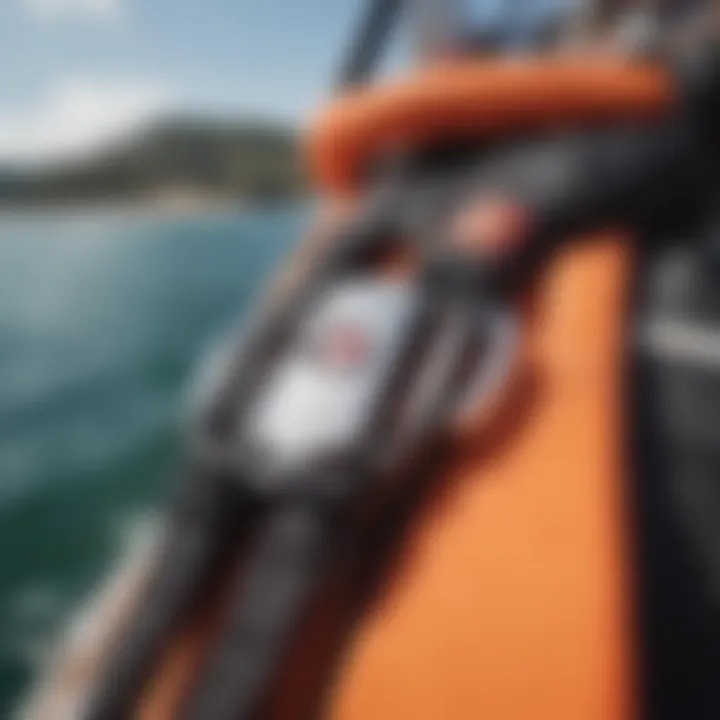
In summary, a well-informed purchase decision takes into account not just the immediate need but also your evolutionary journey as a sailor. Remember, nothing is worth it if it compromises your safety while still chasing tides.
Review of the Top Sailing Harnesses
When it comes to sailing, having the right harness can make all the difference between a delightful day on the water and a harrowing experience. \n Examining the best sailing harnesses brings to light various elements that every enthusiast should consider. The section aims to highlight features that not just enhance performance but also prioritize safety and comfort. As sailors know, feeling secure in your gear often translates to a better experience when faced with the unpredictability of the sea. \n Engaging with specific products allows us to emphasize which options are worth their weight in gold based on rigorous analysis of materials, user feedback, and overall utility. Let's break it down into high-end options, mid-range choices, and budget-friendly selections. Each category appeals to different preferences and financial considerations.
High-End Options
Features and Benefits
When we talk about high-end sailing harnesses, we’re diving into a world where quality reigns supreme. These options often boast top-notch materials that resist wear and tear, even in harsh conditions. Take the Selden XTR, for example. Its webbing is designed with ultra-lightweight Dyneema, providing both strength and minimal weight without sacrificing comfort. This feature alone makes a high-end harness a popular choice amongst seasoned sailors.
Moreover, advanced safety features, like built-in flotation aids, set these harnesses apart. It’s a reassurance that you are not just investing in a product, but rather prioritizing your safety. However, the flip side could be the steeper price tag, which might deter some from considering these premium options. \n
User Feedback
User feedback plays a crucial role in identifying how well these harnesses perform in real life. The chorus of praises for the Mystic MK8 harness speaks volumes about its comfort and fit. Sailors appreciate its easy adjustability, allowing wearers to tailor it to their specific body shapes. A unique aspect appreciated by many is its breathable mesh lining; it's a game changer in hot climates.
While there’s a lot of positive buzz, it’s important to note some criticisms, like its bulky design which might feel cumbersome to newcomers. Yet for enthusiasts who spend hours on the water, these drawbacks often pale in comparison to the benefits it provides.
Mid-Range Choices
Value for Money
Mid-range sailing harnesses are the unsung heroes, delivering solid performance without causing a financial hangover. The Gill Race harness epitomizes this category. Many users commend its robust build, which strikes a fine balance between durability and weight. The inclusion of adjustable leg loops allows for a snugger fit, enhancing overall safety while navigating tricky conditions.
Notably, these harnesses often include essential features like reinforced stitching and corrosion-resistant buckles, ensuring they last through the years. The only noteworthy concern would be that while they perform admirably, they may not have the extra bells and whistles found in high-end models. But for most sailors, practicality is king.
Performance Analysis
An in-depth performance analysis of mid-range options shows these harnesses consistently meet the needs of average sailors. The Nexus harness, celebrated for its versatility, supports various sailing styles. Reviews highlight that it doesn’t skimp on comfort, even during long hauls. Users have pointed out how it stays put during sudden shifts in wind, which is invaluable on the water.
However, preference can be subjective. While some may find it perfect for everyday sailing, others dreaming of competitive racing might feel it falls short against premium gear. In the end, it’s about aligning gear with individual sailing aspirations.
Budget-Friendly Selection
Cost-Effectiveness
Budget-friendly sailing harnesses often fly under the radar, yet they hold immense value for casual sailors. The Prolimit Fusion harness, for instance, is a stand-out for its affordability while still boasting decent construction. Many find that it provides the essential features they need to set out to sea without breaking the bank.
The key characteristic is its basic but effective design. Users have been pleased to find that it offers reliable safety features, such as a secure buckle system, even at a lower price point. It’s ideal for learners who are just starting to explore the adventure of sailing. In contrast, the trade-off may be fewer high-end features, but it’s hard to argue against its practicality for beginners.
Durability and Reviews
The durability of budget options, like the Ronstan Classic harness, can be impressive given the price range. Users frequently report satisfaction with its longevity, even after frequent use. It has gained attention for its sturdy fabric that holds up well against constant wear from saltwater and sun exposure.
However, the downside can be the lack of advanced features. Many users wish for more comfort and adjustability. But for someone just getting their feet wet, this harness offers enough reliability without overwhelming them with choices. It's the perfect stepping stone into the world of sailing.
In summary: Whether considering high-end, mid-range, or budget options, understanding the spectrum of available sailing harnesses enables enthusiasts to make informed choices that elevate their sailing experiences.
Proper Usage and Techniques
Understanding how to properly use a sailing harness goes beyond just wearing it. This section emphasizes its significance in ensuring safety and maximizing performance on the water. The right techniques may not only enhance your sailing experience but also minimize risks associated with improper use. Many enthusiasts may overlook these details, thinking that once a harness fits right, they are good to go. However, it is crucial to master the methods involved in using the harness effectively.
Fitting the Harness Correctly
Wearing a sailing harness may seem straightforward, but getting the fit just right can be a lifesaver, literally. A snug fit will help distribute the forces exerted on the body evenly, which is key when battling strong winds or turbulent waters. Here��’s how to ensure your harness is correctly fitted:
- Adjust the Straps: Before setting sail, adjust all straps while standing. The waist and leg straps should be secure without pinching or constricting movement.
- Check for Movement: Lift your arms above your head; the harness should stay in place, snug against your body. If it rides up or shifts, further adjustments are necessary.
- Test the Emergency Release: Familiarize yourself with the emergency release mechanism. Ensure it is easily accessible and operates smoothly without a hitch. This knowledge will be invaluable in an emergency.
Getting this part right enhances comfort while allowing for a full range of motion as you steer and control the boat. Remember, an ill-fitted harness can lead to fatigue and increased risk of injury.
Safety Protocols while Sailing
Safety should be at the forefront of every sailor's mind, and a proper harness aids significantly in this regard. Below are some crucial safety protocols every enthusiast should adopt:
- Always Wear a Life Jacket: Your harness should be worn over a life jacket. Together, they provide buoyancy and prevention against falls overboard.
- Communicate with Your Crew: Establish hand signals or other forms of communication before setting sail. It should go without saying that clear communication can avert potential mishaps.
- Practice Quick Releases: Regularly go through scenarios requiring quick release of the harness. This practice will ensure everyone knows how to react swiftly if something goes wrong.

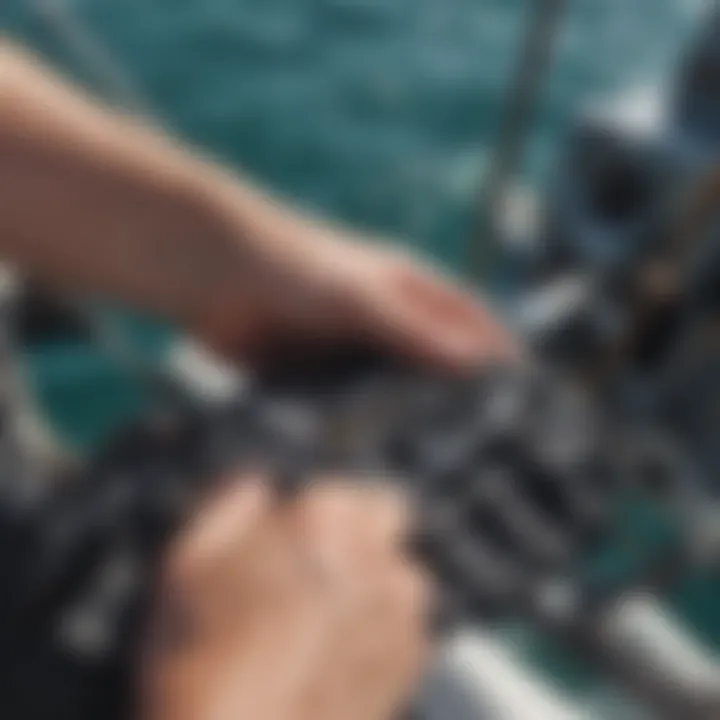
"The ocean is a mighty force, and sailing requires respect for that power. The right technique and precautions will help keep you safe while you explore its depths."
- Secure Loose Items: Check that all equipment and personal items are secured. Loose items can not only become projectiles but also catch on the harness, causing serious accidents.
By integrating these safety practices into your sailing regimen, you’ll ensure not just your own safety but that of your crew as well. Proper usage and techniques can mean the difference between a thrilling adventure and a harrowing ordeal on the water.
Maintenance and Care
Maintaining your sailing harness isn’t just about keeping it looking sharp. It plays a crucial role in your performance and safety on the water. When you regularly care for it, you're upping your chances of having a smooth sailing experience. A clean and well-cared-for harness can help prevent accidents due to wear and tear, ensuring that every hook and strap functions as intended. Moreover, proper maintenance can extend the life of your gear, giving you more time out on the waves.
Cleaning Procedures
Cleaning your sailing harness should be part of your routine, similar to checking your gear before heading out. Salt water, sand, and even sunscreen can create build-up that may affect the harness's integrity over time. In fact, ignoring this can lead to corrosion or even mold, especially if you sail in humid conditions.
To clean your harness, follow these steps:
- Rinse Thoroughly: After each sailing session, give the harness a good rinse with fresh water. Make sure to reach all the straps and buckles, as salt can get stuck in crevices.
- Gentle Scrub: For tougher stains, use a soft brush. Avoid harsh cleaners or abrasive pads that could damage the fabric. A mild detergent mixed with water often does the trick without harsh effects.
- Drying: After cleaning, let the harness air dry away from direct sunlight. Prolonged exposure to sunlight can weaken the material, so find a shady spot if you can.
- Inspect: Check for any signs of wear and tear. Look out for frayed edges or faulty buckles that might need replacement.
"A little maintenance goes a long way to keep your harness functional and safe on the water."
Storage Tips
Once your harness is squeaky clean and dry, proper storage is the next step. It might sound simple, but how you store your gear can significantly affect its lifespan. Remember, a well-stored harness is a happy harness. Here’s how to store it effectively:
- Dry Completely: Make sure your harness is completely dry before putting it away. Storing damp harnesses can lead to mildew and unpleasant odors.
- Avoid Creases: Hang your harness on a sturdy hook or loop it over a padded hanger. This prevents creasing and helps maintain its shape.
- Temperature Considerations: Store it in a cool, dry place. Extreme heat can degrade materials, while extreme cold can make them brittle.
- Keep It Away from Chemicals: Make sure it’s kept away from any chemicals or harsh substances that may damage it.
By following these maintenance and care tips, you’ll not only prolong the life of your harness but also ensure you’re ready for the next adventure on the water. Maintaining your gear is just as important as the sailing itself; they go hand in hand.
Future Trends in Sailing Harness Design
In the world of sailing, the gear one chooses can make a world of difference. As enthusiasts seek more comfort, efficiency, and safety, harness designs are evolving faster than a gust of wind. Understanding future trends in sailing harness design is paramount for both casual sailors and seasoned pros. This section explores how technological innovations and sustainability efforts are reshaping the sailing harness landscape, bringing benefits like enhanced performance and reduced environmental impact.
Technological Innovations
The sailing industry is no stranger to technology, and the harness segment is also seeing some revolutionary changes. A notable trend is the inclusion of smart technology within harness designs. Imagine a harness equipped with sensors that monitor your heart rate, temperature, and even water exposure. Such features not only add to safety but also provide real-time feedback to the user, enhancing performance on the water.
Another exciting development is the use of advanced materials. For instance, some brands are using ripstop fabrics that are lightweight yet highly durable. This innovative material reduces the overall weight of the harness, providing better mobility without compromising on strength.
Moreover, there’s a push towards customizable harnesses. These harnesses adapt to the individual’s body shape and sailing style. With 3D printing technology, sailors could soon personalize their harnesses to achieve the perfect fit, giving that 'second skin' feel that many look for in high-performing gear.
“It's the innovations in design and tech that separate the weekend sailor from the true enthusiast.”
Sustainability Efforts
As awareness of environmental issues grows, the sailing industry is starting to embrace sustainability. More manufacturers are beginning to focus on eco-friendly materials. For example, harnesses made from recycled plastics or organic materials are becoming available. This not only helps to reduce waste but also attracts eco-conscious consumers who want to make a positive impact through their choice of gear.
Additionally, brands are prioritizing ethical production practices. Fair labor conditions and transparent supply chains resonate with today’s consumers who prefer to support companies with a conscience. Given the significant amount of gear waste in the sailing community, efforts to promote recycling and upcycling of old harnesses are also on the rise. Mariners are now encouraged to return their old gear for proper recycling, contributing to a circular economy.
Harness designs of the future are set to not just support the sailor but also the environment. By focusing on sustainability, the sailing community takes a crucial step forward in preserving the natural beauty that sailors cherish so much.
Through awareness of these emerging trends, sailors are invited to make more informed choices, understanding that the right harness not only enhances their sailing experience but also contributes to a larger cause of environmental stewardship.
Epilogue
As we navigate through the ins and outs of selecting the best sailing harness, it becomes clear that this topic is not merely about choosing an accessory; it’s about ensuring safety, comfort, and an overall enhanced sailing experience. The right harness can make a world of difference for enthusiasts, whether they're out on calm lakes or braving choppy seas. A well-fitting harness enhances not just performance but also the overall enjoyment of being on the water.
Harness design has a direct influence on how effectively sailors can handle their vessels. Features such as material quality, adjustability, and built-in safety mechanisms are not just bells and whistles—they're crucial for maintaining control and ensuring safety in challenging conditions. The importance of these elements resonates throughout the article, emphasizing that both novices and seasoned sailors stand to benefit significantly from a thoughtful shopping process.
Adhering to proper usage and maintenance techniques further amplifies the value of a good harness. Many opting for the wrong model might find themselves uncomfortable, restricted, or worse, unsafe. The recommendations throughout this article weren’t just thrown in; they're the result of thorough research and real user feedback, all aimed at protecting sailing enthusiasts while optimizing their experience.
Ultimately, selecting a harness extends beyond simple preference. It becomes a pivotal aspect of sailing strategy.
Summary of Findings
In summation, this article elucidates several key factors in selecting the right sailing harness. The discussion has brought to light the significance of harness type, fit, and safety features.
- Material quality is paramount for durability and comfort.
- Adjustability ensures that the harness can accommodate various body types and sailing conditions.
- Safety features, such as emergency release mechanisms and smart sensors, play an indispensable role in protecting the user during unpredictable scenarios.
Furthermore, the importance of maintaining your harness and understanding future trends in design has been highlighted as well, offering insights into how technology and sustainability will shape the industry ahead.
Final Recommendations
When it comes to making a final decision on the best sailing harness, here are some pointers to consider:
- Experiment with Types: If possible, try various harness types (waist, seat) before you buy. What works for one sailor may not work for another.
- Prioritize Fit and Comfort: Make sure the harness is snug but not constrictive. Your movements shouldn’t be hindered.
- Shop Smart: Balance your budget with your needs. Investing in quality may save you money in the long run.
- Stay Updated: Keep an eye on emerging trends and tech that could elevate your sailing experience.

